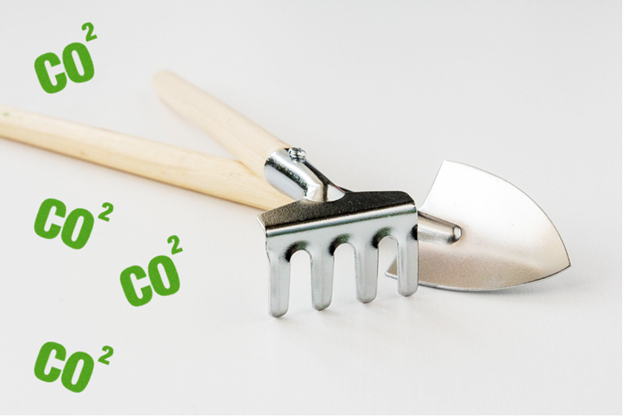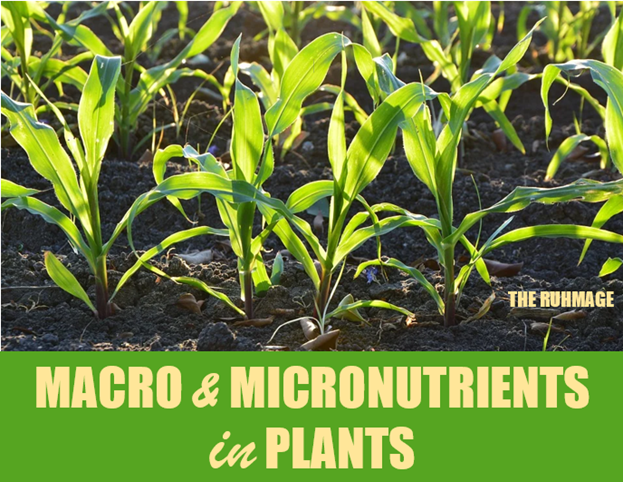With the indoor gardening coming along, it is good to know the nutrients required for plant growth. While familiar with some macronutrients needed by plants, I am discovering that it is good to at least be familiar with all the nutrients plants need.
There are both micro and macronutrients in plants Therefore, the essential nutrients required for plant growth can be divided into two main categories including: (1) macronutrients and (2) micronutrients. Together, there are 17 essential plant nutrient requirements for plant metabolism and growth. Without all of the essential nutrients required for plant growth by that plant, the plant will be unable to complete a normal life cycle.
Macronutrients
The nine “macro” nutrients required for plant growth are simply nutrients that the plant will need and take up in relatively larger amounts than the “micro” nutrients they require. Fortunately, the carbon (C), hydrogen (H), and oxygen (O) are macronutrients provided by means of the air and or the water.
- Carbon – When we humans exhale, we exhale carbon dioxide (CO2) into the air. Plants use the carbon dioxide that we expel into the air and in turn the plants produce and expel the oxygen that we need to breath and inhale into the air. Since this a nutrient provide in the air, talking to your plants is not just a theory for help your indoor plants thrive.
- Hydrogen – A water (H2O) molecule contains two hydrogen atoms and one oxygen. Therefore, rain and water provides the plants with needed hydrogen and oxygen.
- Oxygen – You know that water (H2O) can supply the plants with oxygen. However, plants also produce and expel oxygen into the air. that can be utilized. Then, we too expel small amounts of oxygen into the air when we exhale as well. Not to mention the two oxygen molecules hanging off the carbon dioxide (CO2) that we exhale generously into the air.
So, if you water your plants and at least breath on your plants, you have got the first three nutrients required for plant growth covered! In fact, some plants like green onion in water grow well in just water!
Soil-Derived Macronutrients
The remaining six macronutrients are soil-derived macronutrients including nitrogen (N), phosphorus (P), potassium (K), calcium (Ca), sulfur (S), and magnesium (Mg). The nitrogen, phosphorus, and potassium are the popular N-P-K ratios that you often see on standard plant fertilizers.
- Nitrogen – Nitrogen is responsible for making plants green. Plants need a lot of nitrogen because it used to form the protein structure of the plants. The nitrogen in the soil can be used by the plants from ammonia (NH4+) and nitrate (NO3-) sources[0]. If the nitrogen is deficient in the plant, older plant leaves may turn a yellow or yellow green color. Nitrogen can be introduced into the soil in a variety of very interesting ways. However, if you know your plant has a nitrogen deficiency, one of the easiest and most convenient ways to resolve the issue is to just add a nitrogen plant fertilizer. But there is more to learn regarding this.
- Phosphorus – Phosphorus promote root development that helps strengthen and stabilize plants[0]. On a cellular level, this macronutrient is responsible for the basal metabolic energy of the plant. Basal metabolism can be defined as, “the minimum level of energy required to sustain the vital functions of organisms”[0]. A phosphorus deficiency can be difficult to observe with the naked eye. Therefore, a deficiency is typically determined with a simple pH soil tester. A soil with a pH between 5.5 – 6.5 is considered to have an adequate level of phosphorus available in the soil for plant uptake. It is considered to be inadequate when the pH of the soil is above 6.5 or below 5.5. If a deficiency is likely, you can conveniently remedy the situation with a phosphorus plant fertilizer. But, again, there is more to learn regarding this.
- Potassium – Plants utilize potassium from the soil as potassium. It plays a role in the water and plant energy relationship. Fortunately, this deficiency is relatively easy to spot as the edge of older plant leaves turn yellow with a mild deficiency or completely brown with a severe deficiency. This is a deficiency was spotted on the indoor basil plant grown from cuttings with a very simple potassium plant fertilizer solution.
Along with the carbon, hydrogen, and oxygen provided in the water and/or air, the nitrogen, phosphorus, and potassium (N-P-K) completes the six primary nutrients required for plant growth that most fertilizers contain. If your soil test kit reveals a specific N-P-K deficiency, you can choose an N-P-K fertilizer with a ratio that can help adjust your particular soil deficiency. Otherwise, many new gardeners simply start with an all purpose plant food that contains both micro and macronutrients required for plant growth.
- Sulfur – Like nitrogen, sulfur helps to build and form the protein structure in plants. Plants can utilize sulfur in the form of sulfates (SO42-). A sulfur deficiency will become apparent in new plant leaves first giving them a greenish yellow or yellow appearance. Excessive watering can cause a sulfur deficiency. This deficiency can be remedied with a sulfur fertilizer for plants.
- Calcium – Plants can use calcium in the form of Ca2+. This macronutrient is one of the plant nutrient requirements for cell division, cell growth, and cell structure. Therefore a calcium deficiency may be noted at the ends of leaves that are growing. You can treat this with a calcium fertilizer for plants which often comes as a calcium-magnesium fertilizer.
- Magnesium – Magnesium is a component of chlorophyll. Therefore a deficiency may be evident by dark colored veins in older plant leaves accompanied by the leafy part of the leaves being yellow green. Plant can use magnesium as Mg 2+. A magnesium deficiency can be treated with a magnesium fertilizer for plants. It is often provided as a calcium-magnesium fertilizer combination. However, you can find magnesium sulfate plant fertilizer.
Soil-Derived Micronutrients
The eight soil-derived “micro” nutrients required for plant growth are sometimes called trace minerals. Iron (Fe), boron (B), chlorine (Cl), manganese (Mn), zinc (Zn), copper (Cu), molybdenum (Mo), and nickel (Ni) are the trace minerals needed by plants. These trace minerals are soil-derived nutrients needed for plant growth in comparatively smaller amounts.
- Boron – Plants can use boron when it is in a neutral (H3BO3) or a negative (H2BO3–, HBO32-) form. It is believed to help with the cell formation and the reproductive growth of the plant. It is therefore most needed at the location of active cell division[0]. A boron deficiency can be caused by over watering your plants. The deficiency is usually seen at the end of a new leaf as it grows in a deformed manner. A boron deficiency is often treated with borax, which is a popular cleaning agent used to make laundry detergent.
- Chlorine – Chlorine is required for oxygen production in photosynthesis[0]. Plants can use this micronutrient in the form of Cl–. Chlorine is found in the soil in higher concentrations in areas near the sea[0]. A chlorine deficiency can first be noted by wilting of the leaf edges.
- Iron – Iron is needed for chlorophyll synthesis, enzyme activation, and different metabolic processes. Plants take up iron in the form or Fe2+. A plant iron deficiency will present itself in a similar way that a manganese deficiency may present itself. The new leaves will develop something called interveinal chlorosis (yellow leaves and dark green veins). This too can be remedied with an iron fertilizer for plants.
- Manganese – Manganese is required for photosynthesis and enzyme activation. Plants can use this micronutrient as Mn2+. A manganese deficiency can occur when the pH of the soil goes beyond 6.5 because it can no longer be taken up by the plant0]. The way plants use manganese, a deficiency will be seen in newest developing plant leaves first with yellow leaves and dark green vein[0].
- Zinc – This micronutrient is required for enzyme activation and protein synthesis [0]. Plants can use this micronutrient as Zn2+. A zinc deficiency is rare. It can present itself in different ways in different plants with chlorosis or with dead dark leaf tips.
- Copper – Copper is taken up by plants in the form of Cu2+. It is needed for enzyme activation. A deficiency presents in the newly developed leaves.
- Molybdenum – This micronutrient has an interesting feature in that it helps legumes fix nitrogen. Plants can use molybdenum in the form of MoO42-.
- Nickel – This micronutrient is believed to play a role in iron metabolism. It is needed in an extremely small amount by plants.
Unless you are aware of a specific micronutrient deficiency, many new gardeners just start with a “catch all” micronutrient plant fertilizer that should have appropriate micronutrient ratios needed. In this way the nutrients required for plant growth are not exceeded. A micronutrient deficiency can become a micronutrient toxicity when more nutrients are given than needed. And, as a result, plant development is hindered until whatever plant toxicity development is resolved.
Conclusion
This concludes the list of nutrients required by plants! You now know the nine macronutrients required by plants as well as the eight micronutrients required by plants. The nine macronutrients come from the air, water and soil while the remaining eight are soil-derived minerals required by plants. If you are doing some indoor gardening or some outdoor gardening, these are the essential nutrients required for plant growth. This completes the nutrients required for plant growth.



